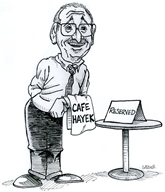Phil Gramm and Mike Solon credibly predict that “the AI revolution will bring prosperity.” A slice:
In the 19th century the U.K. and U.S. governments were small and largely noninterventionist. Today both governments are large and filled with political interests eager to expand government’s role in the economy. Sen. Bernie Sanders has embraced the Luddites’ cause, calling for taxes on robots. President Biden issued an executive order imposing government oversight of the use of AI and requiring AI to promote unionism, improve the environment and advance “equity” and civil rights. The AFL-CIO president has said “working people are fighting back against artificial intelligence and other technologies used to eliminate workers or undermine and exploit us.” And this is only the beginning.
Almost every discussion of AI calls for extensive economic assistance for those who are displaced, and a growing chorus calls for a guaranteed income. These proposals show no awareness that while trade adjustment assistance, extended unemployment and our welfare system were no doubt well-intended, they have impeded workers’ transition to new jobs. Impediments are already being raised to AI. Mr. Biden launched a wave of antitrust actions against big tech that the Trump administration largely has continued.
American exceptionalism—in which Americans are more productive and have higher living standards—depends in part on our extraordinary ability to adjust to change. Europe makes it hard to lay people off, which constrains the ability to create jobs. In China, most industrial subsidies go to noncompetitive industries, not to the potential winners of the future.
Speaking of AI, John O. McGinnis makes clear that “a legal regime of strict liability standards for AI safety is not in the interest of either innovation or our national security.”
Megan McArdle warns that nostalgia for the past – a past seen through rose-tinted lenses that blind wearers to the full picture – fuels bad public policy. Two slices:
Or take travel nostalgia, a perennial favorite among lower-tier white-collar workers. As we cram into cattle class and contemplate our grim bags of stale pretzels, we salivate over those old ads featuring steak dinners or cut-to-order charcuterie being served to grinning passengers dressed to the nines. We forget why those passengers were dressed in their Sunday best rather than their sweatpants. Air travel was extremely expensive, so it was an elite experience that people dressed up for. (In the 1950s, my mother was required to wear a hat and gloves just to pick people up at the airport.)
In 1951, Trans World Airlines would fly you from New York to Los Angeles for only $110 — almost $1,400 in today’s dollars, for an 11-hour trip on a noisy propeller plane. That’s one way. Today American Airlines, which bought TWA in 2001, will sell you a round trip for $427 that goes nonstop in half the time. The food was in part compensation for the cost and experience — the quality of the food matters more if you are going to be stuck in your seat for an entire day, which is why long international flights still offer better food and amenities than short domestic hops.
…..
Old things were better in certain ways, but they were not better, period, unless you ignore critical dimensions such as convenience, safety and cost. Dreaming of the past while imagining all the drawbacks away is … well, a dream.
While dreams are fine, in their place, I’m afraid we’re not doing a great job of keeping them there. Those fantasies belong to the realm of pure imagination, along with fairies, elves and Powerball tickets. But my social media feed is filled with people who seem to take them seriously, including the vice president, who has a thing for old refrigerators, and the president of the United States, who wants to tariff our way back to the McKinley administration. We can’t go back to those days, but more importantly, no one would want to, if they actually understood what it would cost.
Will Rinehart tweets: (HT Scott Lincicome)
There’s a fascinating contradiction at the heart of Trump’s economic team: some advisors want de-dollarization to fix trade imbalances, while Trump himself threatens any country that tries it.
Robert George, writing at National Review, explains why he rejects ‘No enemies to the right.’ A slice:
So, while I understand and appreciate that politics is about “adding and multiplying, not subtracting and dividing,” and though I welcome conservatives representing a range of viewpoints on a wide swath of issues, I will not — I cannot — accept the idea that we have “no enemies to the right.” The white supremacists, the antisemites, the eugenicists, the bigots, must not be welcomed into our movement or treated as normal or acceptable.
Is this a call for “cancellation”? No. It’s a reminder that we conservatives stand for something — or should stand for something. We have core principles that are not negotiable.
The Wall Street Journal‘s Editorial Board decries the bigotry, intolerance, and sheer ignorance of the likes of Tucker Carlson and Nick Fuentes. Two slices:
Mr. Fuentes has free speech and uses it to fantasize about killing and deporting Jews. Is it now “cancel culture” to criticize Mr. Carlson for treating Mr. Fuentes like a political truth-teller and feeding him softball questions? This is a parody of what “cancel culture” meant when the campus left shouted down conservative judges and scholars. Mr. Cruz nailed the point when he said Friday that “if you say nothing when someone tells you that Adolf Hitler was cool, you are a coward and complicit in evil.”
…..
If conservatives—and Republicans—don’t call out this poison in their own ranks before it corrupts more young minds, the right and America are entering dangerous territory.
Michael Cannon sensibly asks: “What will it take for Congress to admit Obamacare has failed?”
Tyler Cowen reflects on 2025’s freshly minted economics PhDs. A slice:
The number of people on the market seems much lower this year, perhaps because of the lag with Covid, as well as more general demographic trends. Even adjusting for the lower number of candidates, I found fewer interesting papers this year than usual, as research interests continue to narrow. There is too much emphasis on showing quality technique by answering a small question well, rather than addressing more important questions more imperfectly. Harvard had by far the most interesting students, as most of them were considering questions I cared about. LSE looked pretty good too. In terms of topics, I saw a lot of papers on educational testing, urban economics and mobility, and AI. Theory seems to be permanently on the wane. The number of co-authors continues to rise.
Overall I came away with a bad feeling from this year’s perusal, noting there are some departments I have not looked at yet.
The charge that choice will destroy public schools boils down to confessing that public schools are so rotten that, if given a choice, parents would opt out. Saying that parents can’t make wise choices is another example of the education establishment’s demeaning and paternalistic attitude. Even the most ill-informed parent could not do as much educational harm as many public schools now do.


 What a wonderful world this would be if there were as many wise people as there are clever people.
What a wonderful world this would be if there were as many wise people as there are clever people. People who talk about helping “the little people” give me a pain. People are the same size, and have the same importance as human beings, whether they are rich or poor. Paternalism toward others has long been camouflage for power and an ego trip for oneself.
People who talk about helping “the little people” give me a pain. People are the same size, and have the same importance as human beings, whether they are rich or poor. Paternalism toward others has long been camouflage for power and an ego trip for oneself.
